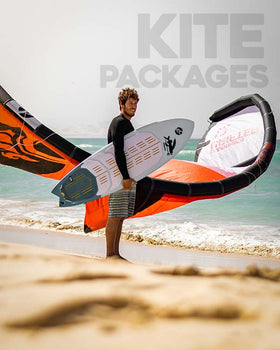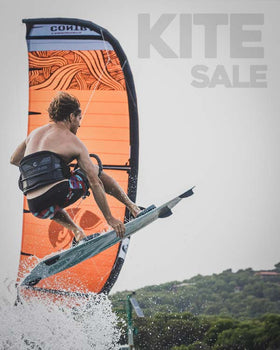
Making Sense of Foils
Foiling with a kited has been around for some time but in recent years it has really exploded. First to catch on to the magic of kite foiling were the racers. For a little while, super fast foils were the norm which made foiling pretty challenging for the average rider to get into. Next, came the all-around foils. Designed to make foiling easier, these foils could get on foil at slower speeds thereby opening the discipline up to more riders. But over the last 2 years, something transformative happened. The surf foil came into being, largely through the experimentations of Kai Lenny. These foils were designed to foil at very slow speeds and all of a sudden people began to realize that besides allowing you to foilsurf, surf foils made kitefoiling hugely easier. Surf foils, with their wide wingspans, thick profiles and fat aspect ratios have allowed many more riders to learn how to foil. Not only do they let you foil at 8 knots, which makes the whole process of learning significantly easier, they are a lot safer, too. Today's foil lineup has something for everyone from beginner to freerider, to freestyler to surf foiler. Additionally, the modular construction of today's foils allows you to swap out different wings and masts so with just the turn of a few screws you can change your foil for different conditions and disciplines.
So, with so many foil setups to choose from, what will be best for you? Well, let's break it down. Your first foil should be on the big side. In general, you can think of surf foils as beginner kite foils. You'll have much better success with a big foil since they are more stable and foil at lower speeds. The wingspan and low aspect ratio of surf foils make them ideal for learning. Anything above 1000cm2 in surface area can be considered a surf/beginner foil. Foils that are between 1000cm2 and about 700cm2 can be considered intermediate level foils. Foils that are smaller than 700cm2 can be considered expert or race foils.

Beginner or surf foils like the Naish Surf M, L, and XL, the Slingshot Time Code, Space Skate, and Infinity 76 and 84, the Liquid Force Impulse, the Neil Pryde Glide, and the Cabrinha HI:RISE Lift are all ideal as a first foil. All of these foils will get you up at the slowest speeds possible to make learning as easy as possible. In addition to the slow speed, these large foils are thicker and therefore safer to ride. When you are learning to foil, we highly recommend getting a short mast that is 24" or smaller. This will significantly reduce the risk factor when starting out as you will most certainly fall a lot. A short mast will keep the foil more out of the way so you will be less likely to fall on it. Once you have some ability the kinds of beginner crashes that can injure you are significantly reduced. We also highly recommend that you do your first foil sessions behind a boat so you can concentrate on just the foil.

Intermediate foils like the Slingshot Time Code 57 and Gama, the Liquid Force Thruster and Rocket, the Duotone Speedster, and the Cabrinha HI RISE Speed are great foils for once you've become proficient at foiling. The large beginner foils are generally slow, which for many riders is fine, provided that you don't care to go very fast. If you do want to go faster, these are the foils that will give you both speed and moderate-speed performance.

Finally, if speed is your jam, race foils like the Naish Kite, the Liquid Force Happy, the Slingshot Warp Speed and Ghost Whisperer 2.0 101 and 111, and the North Speedster GT are made to go fast. You'll want to have your skills dialed before you hop on one of these. It's going to take significantly more speed just to get on foil with one of these speed demons. These foils derive their stability with speed but are rather unstable are marginal speeds.
So, with so many foil setups to choose from, what will be best for you? Well, let's break it down. Your first foil should be on the big side. In general, you can think of surf foils as beginner kite foils. You'll have much better success with a big foil since they are more stable and foil at lower speeds. The wingspan and low aspect ratio of surf foils make them ideal for learning. Anything above 1000cm2 in surface area can be considered a surf/beginner foil. Foils that are between 1000cm2 and about 700cm2 can be considered intermediate level foils. Foils that are smaller than 700cm2 can be considered expert or race foils.

Beginner or surf foils like the Naish Surf M, L, and XL, the Slingshot Time Code, Space Skate, and Infinity 76 and 84, the Liquid Force Impulse, the Neil Pryde Glide, and the Cabrinha HI:RISE Lift are all ideal as a first foil. All of these foils will get you up at the slowest speeds possible to make learning as easy as possible. In addition to the slow speed, these large foils are thicker and therefore safer to ride. When you are learning to foil, we highly recommend getting a short mast that is 24" or smaller. This will significantly reduce the risk factor when starting out as you will most certainly fall a lot. A short mast will keep the foil more out of the way so you will be less likely to fall on it. Once you have some ability the kinds of beginner crashes that can injure you are significantly reduced. We also highly recommend that you do your first foil sessions behind a boat so you can concentrate on just the foil.

Intermediate foils like the Slingshot Time Code 57 and Gama, the Liquid Force Thruster and Rocket, the Duotone Speedster, and the Cabrinha HI RISE Speed are great foils for once you've become proficient at foiling. The large beginner foils are generally slow, which for many riders is fine, provided that you don't care to go very fast. If you do want to go faster, these are the foils that will give you both speed and moderate-speed performance.

Finally, if speed is your jam, race foils like the Naish Kite, the Liquid Force Happy, the Slingshot Warp Speed and Ghost Whisperer 2.0 101 and 111, and the North Speedster GT are made to go fast. You'll want to have your skills dialed before you hop on one of these. It's going to take significantly more speed just to get on foil with one of these speed demons. These foils derive their stability with speed but are rather unstable are marginal speeds.



Leave a comment